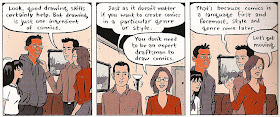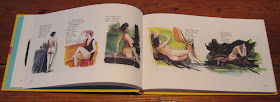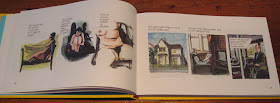My final post for the now-defunct
Panelists blog was for our series celebrating the fifth anniversary of First Second Books. Before I get to it, let me say that I am genuinely sad that I couldn't contribute more to
The Panelists while it was alive. My paying work has made it impossible for me to write much at all lately, and although I had (and have!) ideas for short essays I wanted to write, I never got to them.
The thing that I liked best about
The Panelists was the real feeling of camaraderie, of shared purpose, even among scholars and critics whose tastes don't perfectly agree. Probably if you placed all the comics in the world on the table between the six of us, there would be not a single book that we would
all want to take home for the top shelf of our personal canon. Things that got Charles and me fired up would leave Derik cold. The Venn diagram of our tastes would be hard to draw. But we worked well as a team, making a whole that, when it was functioning, was greater than the sum of its parts.
Early in the team's history, my image for our collected powers was of a great Voltron of comics criticism. The sad thing was to watch that Voltron try to march into battle with both its legs and one arm totally asleep. (In this image, I would be one of the useless legs.)
I'll miss the Panelists, more for its potential than for its actuality; more for what it represented to me than for what it managed to become.
Our comics culture needs more places for careful and sustained snark-free criticism, where every claim is supported with thoughtful evidence and every quibble is launched in the spirit of arriving together at a better understanding of the medium's inner workings.
Anyway, here's the last squib I managed to scribble.

The first time I taught a course on making comics, the closest thing I had to a textbook or instruction guide for the students was Scott McCloud’s then-new
Making Comics. I wound up using parts of the book, skipping other parts, and generally wishing I had something that I could use all the way through the semester.
Thanks to First Second, I now have a serious alternative, in Jessica Abel and Matt Madden’s
Drawing Words & Writing Pictures. Organized around lessons and exercises,
DWWP moves through a series of skills that build incrementally: composition and drawing basics are followed by more elaborate lessons and work on progressively larger units, from the panel to the strip, from the story to the zine. If I find myself teaching another class on making comics, I’m sure I’ll assign it. In fact, there are patient explanations of the use of things like Pro-White and the Ames Guide in
DWWP that I should probably re-examine if I ever make comics seriously again myself: there’s a lot I could learn from this book.
For the moment, however, I want to consider the benefits of a competing textbook, also published by First Second. This other book covers less ground and isn’t as thick, but it also retails for less than half the price. There are reasons I probably shouldn’t assign it, including the fact that it offers no technical instruction at all—there’s not even a mention of inking, let alone brush technique or cross-hatching—but as instruction manuals go, it has definite strengths. In some ways, it might even be more appropriate for the kind of course or the kind of students I’d be likely to teach. (I'm in an English department, not an art department, so I
teach comics-making as a kind of creative writing.)
I’m alluding to
Adventures in Cartooning, the how-to-make-comics manual for kids that presents itself as a light fantasy romance with a knight, a missing princess, an elf, and a dragon. A collaboration between James Sturm and two Center for Cartoon Studies graduates (Andrew Arnold and Alexis Frederick-Frost),
Adventures in Cartooning offers a series of lessons in comics practice while telling a suitably silly quest story with a couple of nice twists in its conclusion. It’s pitched, I think, at precisely that age range where kids either might get into drawing stories other people could read or, without a supportive environment, might give up drawing altogether. And yet I would like to consider, here, some lessons in
Adventures that the blooming late-teen college-aged cartoonist would also do well to observe:
1. You don’t have to be able to “draw well” to make a good comic (or a fun one). This point arises briefly in
Drawing Words & Writing Pictures, but so much of that book gathers its examples and its exercises from superlatively competent work that it could still be daunting for a novice or a doodler. (If your handbook is going to have guidance on feathering or drybrush technique, it’s naturally going to move a long way beyond examples of what you can do if you “can’t draw.”)

("You don't have to be able to draw, but we'll assume that you want to learn how.")
The idea that simple drawings can still tell a story is front and center in
Adventures in Cartooning, which begins with a princess complaining that she “just can’t draw well enough to make a comic”—and immediately contradicted by the Magic Cartooning Elf, who shows how a few basic shapes can be doodled into the main props and settings of the story that follows.

("Anyone can draw that stuff!")
The design of the characters in
Adventures is inspired in part by Ed Emberley’s
Make a World: each is built out of a few simple shapes that are easy to repeat. The difference between this
simple drawing (which is possible for anyone who can write letters) and
bad drawing turns out to be mainly about the difference between gesture and stiffness, not the ability to render a horse that looks like a horse. Here,
Adventures in Cartooning teaches by example: little more than a stick figure, the knight is still full of lively and even exaggerated motion.
2. Since words and images can work complementarily in comics, you can use descriptive words to get you out of a drawing jam.I don’t remember this coming up, at least not in quite this way, in
Drawing Words & Writing Pictures, but it’s a great point for novice cartoonists who aren’t feeling secure in their drawing chops. Some things are hard to
show, but there’s no reason a character can’t
name a thing like that to make its identity clearer. A small closed squiggle can become a bubble-gum wrapper; a few rectangles in the background can become a mile-high stone wall. And let’s remember that even the most painstaking draftsman is still going to rely on language for invisible effects like smell and sound.
3. You don’t have to perform fancy tricks with layout in order to take advantage of “special effects” of panel height, width, and size. Most of the page layouts in
Adventures in Cartooning are straightforward variations on a grid, but each layout is deliberate and directed at a particular effect. (Again the book sets an example for the kid (or student) without much commentary.) A square panel has a different sort of action than a panel with horizontal aspect, because a horizontal panel is better at establishing setting or motion along a surface; a vertical panel is good for ascent, descent, or growth; a row or grid of similar-shaped panels is good for showing progression; and so forth.
 4. Leave room at the top of your panel.
4. Leave room at the top of your panel. One of my favorite moments in the book, which happens before the Magical Cartooning Elf explains the virtues of different-shaped panels, shows the knight and his horse ascending a mountain and, because of the rising ground, seeming to bump against the top of the panel. Maybe this “lesson” isn’t what Sturm and his collaborators had in mind, but I have seen plenty of panels drawn without a thought about speech balloons, then having to crowd dialogue into a tiny attic over the characters’ heads.
 5. Drawing is fun, and drawing together is fun.
5. Drawing is fun, and drawing together is fun. This might be the most important lesson in
Adventures in Cartooning, and again it comes through implicitly, both in the fun of the drawings themselves and in the solution to the knight’s ultimate crisis. (Having fallen in the ocean, several knights are drowning until, working together, they draw a pirate ship they can sail away on.)

("We call this a
jam.")
Little kids mostly don’t need to be told this, but the fun of drawing would probably be the hardest of these five lessons for me to convey in a comics class. That’s because the college students who need this lesson aren’t likely to take a course that requires them to draw every week, and teenagers who think they can’t draw aren’t likely to have an Ed Emberley conversion moment when they’re being graded. By the time young people have passed from the
Adventures in Cartooning target demographic to that of
Drawing Words, they may have been discouraged out of telling stories with pictures. It’s a tragedy
Adventures in Cartooning is trying to forestall. For those lost cartoonists, a healthy dose of Lynda Barry might jolt them back to a kid’s pleasure in making worlds and telling stories. Or maybe I should just casually scatter a half-dozen copies of
Adventures in Cartooning in the library’s study area.
(This post just had a couple of comments, which I've allowed to evaporate into the ether. Perhaps you'd like to add your own now.)







































